How to Create AI Chatbot for Business in 2025? [Essential Guide]
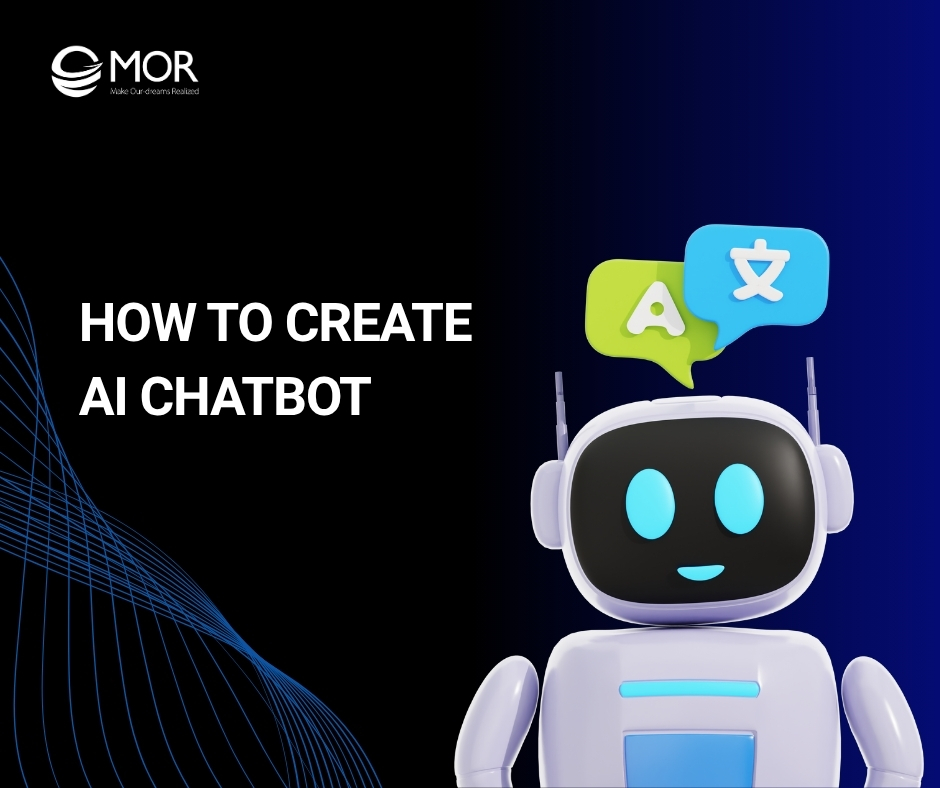
Building smarter customer interactions starts with knowing how to create AI chatbot systems that truly understand users. Many businesses struggle to balance automation with personalization, but the right approach can change everything. This MOR Software’s guide will walk you through practical steps, tools, and insights to build chatbots that drive real results for your business.
Definition Of AI Chatbot
In today’s business world, people often ask, what is a chatbot or how to make an AI chatbot. These tools are now common across websites and apps because they help brands connect with users more naturally. Industry analysts now expect chatbots to become the primary customer service channel for about a quarter of organizations by 2027. This helps explain why they are so visible to customers today.
An AI chatbot is a program that can talk with humans using machine learning and natural language processing. It can understand questions, learn from past chats, and respond in a human-like way. Unlike simple bots that follow fixed scripts, an AI chatbot can adapt to different situations and handle complex requests. In practice, organizations that deploy AI-driven virtual agents often see measurable gains. With one IBM study reporting that 99% of adopters saw an increase in customer satisfaction after rollout.
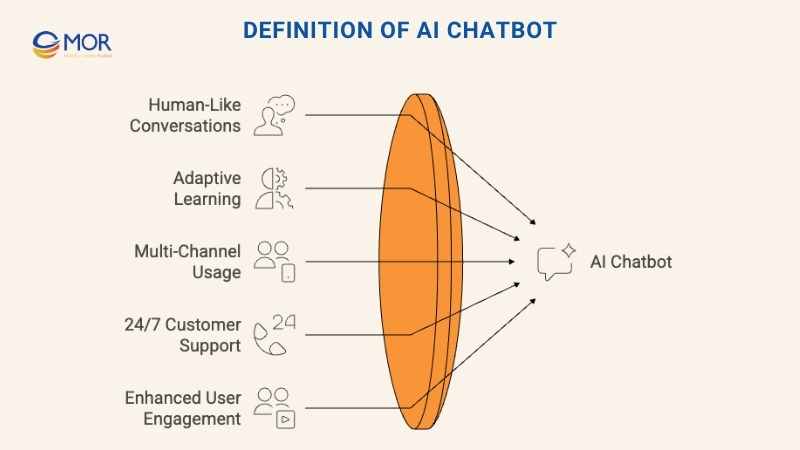
Companies use them on websites, social media, and mobile apps to answer customer questions, guide purchases, or support services 24/7. Learning how to create chatbot systems gives businesses a faster and smarter way to serve customers and improve engagement. Service teams already report meaningful automation. Salesforce data indicating AI automation resolves around 30% of cases in 2025 and is expected to reach about 50% by 2027.
In short, how to create AI chatbot tools is not only a tech trend but a smart step toward better customer experience and business growth.
Main Types Of AI Chatbots
When learning how to make your own AI chatbot, one key step is to understand what kind of chatbot fits your goals. Each type serves a different purpose and helps solve specific problems. Below are the four main kinds used in business today.
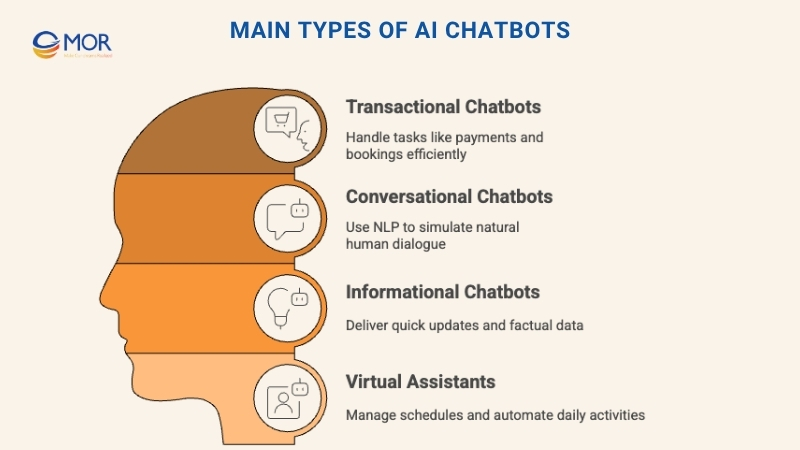
Transactional Chatbots
A simple AI chatbot in this category focuses on carrying out specific tasks such as booking tickets, confirming payments, or tracking orders. It follows a clear pattern that helps users finish their actions quickly. These chatbots are common in banking, online stores, and customer service systems.
In banking alone, analysts estimated that chatbots would deliver about 7.3 billion dollars in annual cost savings by 2023. This shows how much routine transactions can be automated without sacrificing speed.
Conversational Chatbots
This kind of chatbot talks in a natural way. It uses machine learning and natural language processing tools to understand questions and answer them smoothly. Businesses often use these chatbots in support or sales to assist customers and suggest products that match their needs.
During the 2024 holiday season, shoppers used chatbots 42% more than the prior year, a jump linked to broader AI-influenced sales growth across ecommerce.
Informational Chatbots
Informational chatbots share helpful data with users. They can provide news, weather details, or company updates instantly. Many industries, including healthcare, media, and education, rely on this type to keep users informed with accurate information.
Virtual Assistants
These AI-driven helpers are smarter and more flexible. They can schedule meetings, set reminders, or even control smart devices at home. Popular examples include Siri, Alexa, and Google Assistant. These assistants show how far chatbot technology has advanced in daily and business use.
What Enterprises Should Consider Before Creating An AI Chatbot
Before a company starts learning how to build a custom AI chatbot, it must set a clear strategy. Proper planning helps make sure the chatbot supports business goals, fits into existing systems, and delivers real value to users.
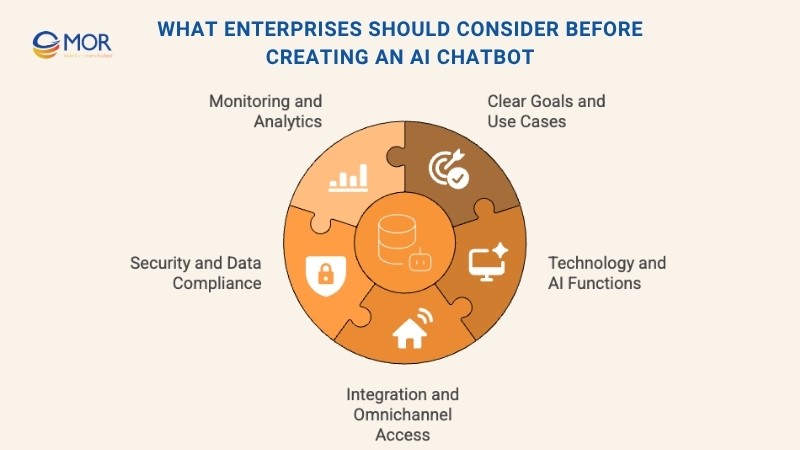
Set Clear Goals And Use Cases
The first and most important step is to decide what the chatbot should achieve. Some businesses want to improve customer service, while others aim to automate daily tasks or collect leads. When goals are specific and measurable, the project becomes easier to manage and success becomes clear.
Having a focused plan keeps your AI chatbot useful and purposeful, not just a tech experiment. A well-defined purpose helps teams stay aligned and ensures that every feature contributes to business growth. This is how enterprises turn enterprise AI chatbot development service into a strong, lasting investment.
Select The Right Technology And AI Functions
Choosing the right tools is one of the most important parts of learning how to create AI chatbot systems that perform well. While solutions like the ChatGPT API offer advanced conversational power, every business should evaluate if the technology fits its real needs. Key points to review include:
- NLP Accuracy: How effectively the AI understands complex or detailed questions.
- Customization Options: Whether the system can adapt to your own data and workflows.
- Scalability: Its ability to manage heavy traffic and future business growth.
The ideal technology should match your chatbot’s expected workload, conversation depth, and long-term goals.
Focus On Integration And Omnichannel Access
A strong enterprise chatbot should connect easily with systems like CRM, ERP, or internal databases. This setup lets it use real-time data to give customers accurate and personal answers. Smooth integration also helps staff work faster and reduces manual effort.
When companies plan for omnichannel access, the chatbot can serve users on websites, mobile apps, social platforms, or messaging tools without limits. This makes the experience consistent and convenient wherever customers choose to connect with the brand.
Ensure Security And Data Compliance
For any enterprise, protecting customer data is a must. A chatbot often deals with private details, so strong security practices are vital from day one. Key steps include:
- Data Encryption: Keep all information safe during transfer and storage.
- Access Control: Restrict who can view or manage chatbot data.
- Compliance: Follow rules such as GDPR, HIPAA, or other industry standards.
Ignoring these measures can lead to serious risks. Building solid protection early helps the chatbot stay reliable and trustworthy as it grows.
Use Monitoring And Analytics To Improve Performance
A chatbot needs ongoing care to stay useful. Regular tracking of its activity, user behavior, and feedback helps maintain quality. Using analytics tools gives businesses clear insight into how well the system performs.
- Find common questions and detect where the chatbot needs better responses.
- Measure success with key metrics like solved cases or customer satisfaction.
- Update its database and conversation flow to keep answers accurate and relevant.
This steady improvement process keeps the chatbot effective and aligned with business goals.
How To Create AI Chatbot Step By Step?
Building an AI chatbot is where planning turns into action. The process involves several key stages that shape how the chatbot works and delivers value to your business.
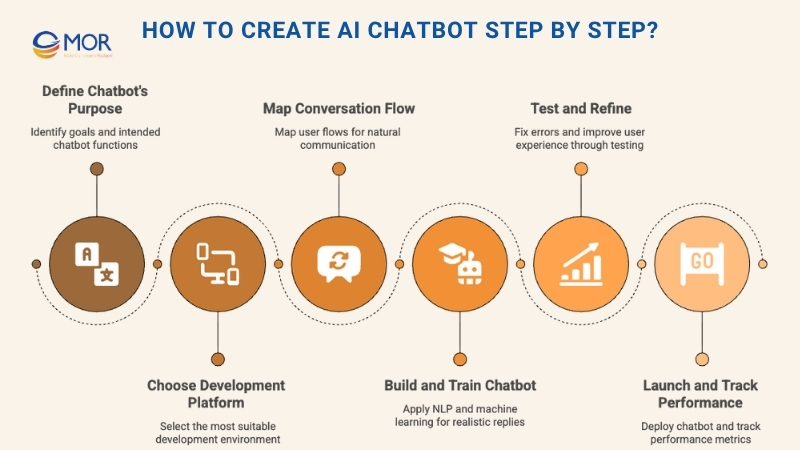
Step 1 – Define The Chatbot’s Purpose
The first step in understanding how to make an AI chatbot is deciding what you want it to do. Identify the main goals, such as answering customer questions, giving product suggestions, helping with bookings, or handling FAQs.
When goals are clear, it’s easier to design a chatbot that truly meets your needs. Setting a strong purpose helps create a focused and helpful system that supports your team and customers effectively. This early step sets the tone for how to make your own AI chatbot that fits your business perfectly.
Step 2 – Choose A Development Platform
After defining your goals, the next move in learning how to create AI chatbot solutions is picking the right development platform. Each option offers its own benefits and works best for different project types.
For example, Microsoft Bot Framework connects well with Azure, making it ideal for large businesses that need advanced tools. Google’s Dialogflow supports natural conversations through strong NLP features, helping chatbots sound more human. OpenAI’s API, with ml model like GPT-4, is perfect for those who want to create an AI bot that understands context and gives smart, personalized replies.
Choosing the right foundation ensures your chatbot performs smoothly and fits your long-term business plans.
Step 3 – Map Out The Conversation Flow
Designing the conversation flow is a key step when planning how to create AI chatbot interactions that feel natural and helpful. Begin by outlining how users will talk to the chatbot, what questions they might ask, and what kind of answers they should get.
Identify common user goals such as asking for support, sharing feedback, or making a request. Then, plan clear responses for each case. Creating a visual flowchart makes it easier to see the full path of each chat, find weak spots, and improve the dialogue. This process helps your chatbot deliver smoother and more human-like conversations.
Step 4 – Build And Train The Chatbot
The next stage in learning how to create AI chatbot systems is the actual development and training process. This includes:
- Building the chatbot’s backend system.
- Connecting it to your chosen enterprise AI platform.
- Applying NLP and machine learning models.
During training, the chatbot studies large collections of sample chats and questions to recognize intent and understand human language better. Developers often use tools like spaCy or NLTK and train the model with real or custom datasets.
Through this process of creating an AI chatbot, the system learns to respond naturally, stay accurate, and handle real conversations with ease. This phase turns a basic idea into a working, intelligent assistant that truly understands users.
Step 5 – Test And Refine
Testing plays a vital role in checking how well the chatbot performs in real situations. It helps confirm that the system works smoothly and gives the right answers to users. Teams can run test scripts and sample conversations to see how the chatbot reacts in different cases.
During this stage, developers look for issues like wrong replies, missed intents, or awkward chat loops. Once these are found, they adjust and improve the system’s logic and responses.
Regular testing ensures progress and keeps the chatbot accurate, natural, and easy to use. This step is key for anyone learning how to make AI chatbots that perform well and satisfy users.
Step 6 – Launch And Track Performance
After testing is complete, the chatbot is ready to go live on your chosen platforms, such as websites, mobile apps, or channels like WhatsApp and Messenger. Deployment includes:
- Setting up system connections.
- Allowing access to databases when needed.
- Configuring backend services for stable performance.
Once launched, the work does not stop. Regular monitoring is crucial to see how the chatbot performs and how users interact with it. Tracking analytics helps identify areas for growth and improvement. Knowing how to set up AI chatbot systems with ongoing updates ensures they stay helpful, reliable, and aligned with user needs.
Core Technologies Behind AI Chatbot Creation
Choosing the right technology stack is a big part of learning how to create AI chatbot systems that are stable, scalable, and efficient. Each layer of technology plays a key role in how the chatbot performs and interacts with users.
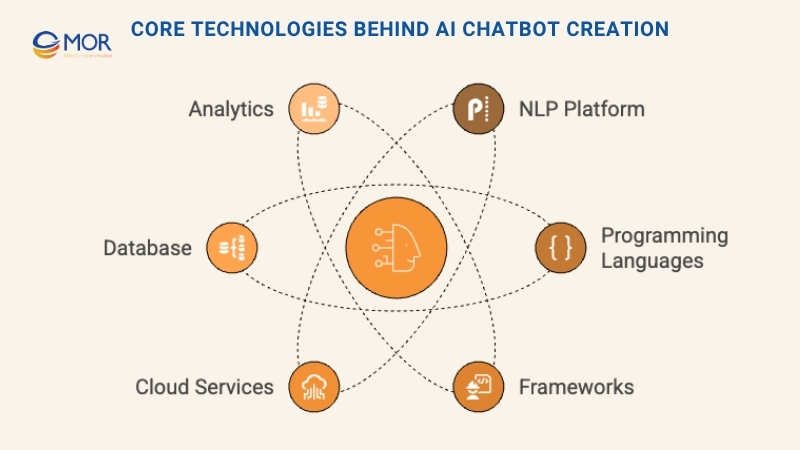
- NLP Platform: Platforms such as Google Dialogflow, IBM Watson, and Microsoft LUIS help chatbots understand and process human language. They use NLP to make conversations sound natural and meaningful.
- Programming Languages: Languages like Python, JavaScript, and Java are widely used because they are flexible, easy to integrate, and supported by large communities.
- Frameworks: Frameworks including Rasa, Botpress, and Wit.ai offer ready-to-use tools for building, training, and managing conversational bots quickly.
- Cloud Services: Cloud platforms like AWS, Azure, and Google Cloud allow smooth hosting, scaling, and performance management for chatbot systems.
- Database: Databases such as MongoDB and MySQL store user sessions, chat history, and responses, helping the chatbot reply faster and stay organized.
- Analytics: Tools like Google Analytics and Chatbase collect performance data, track user activity, and show where improvements are needed.
This mix of technologies helps developers code an AI chatbot that works efficiently and grows with business needs. Next, we’ll explore which features make these chatbots truly valuable.
>>> Let's break down everything you need to know about multimodal AI updates systems, their benefits, and their practical uses in 2025.
Must-Have Features For Every AI Chatbot
An AI chatbot can transform how businesses interact with customers, but only if it includes the right features. These elements make conversations smoother, smarter, and more effective.

Natural Language Understanding (NLU)
This feature allows the chatbot to understand and process human language just like a person would. It identifies intent accurately, helping users get quick and meaningful answers. The better the NLU, the more natural the conversation feels.
Contextual Awareness
A good chatbot remembers past interactions and uses them to shape future replies. It avoids repeating the same questions and ensures the chat feels connected and consistent. This personal touch makes users more comfortable and engaged.
Multi-Language Support
Supporting multiple languages helps businesses reach global audiences. It allows users to chat in their preferred language, improving satisfaction and accessibility across markets.
Integration With CRM And Other Systems
When a chatbot links with tools like CRM or ERP platforms, it can access real-time customer data and business information. This connection makes responses faster, more accurate, and more useful for both customers and staff.
Analytics And Reporting
Data analysis tools inside the chatbot track conversations and performance. They show what users ask most, where the chatbot struggles, and how to make it better. These insights guide businesses to refine both service and strategy.
Voice Recognition
Voice technology lets users talk to the chatbot naturally, without typing. It makes interactions quicker and more accessible, especially on mobile devices or for users who prefer speaking over texting.
With these features in place, it becomes easier to create an AI bot that performs reliably, supports users effectively, and adds lasting value to your business.
Benefits Of AI Chatbot For Your Business
AI chatbots have changed how companies connect with customers. They make service faster, smarter, and always available. When businesses learn how to create AI chatbot systems correctly, they can offer personalized and responsive support that keeps users satisfied.
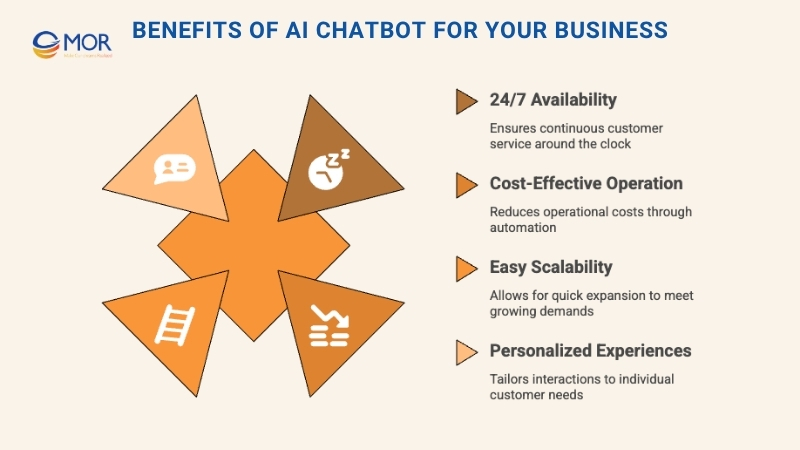
24/7 Availability
AI chatbots stay active around the clock, giving instant answers whenever customers reach out. This constant support improves satisfaction and reduces waiting times.
Cost-Effective Operation
Automating common questions and basic tasks lowers costs and frees teams to handle complex issues. It saves money while keeping service quality high.
Easy Scalability
As demand grows, chatbots can manage more interactions at once without losing speed or accuracy. This makes them perfect for growing businesses.
Personalized Experiences
Using customer data, chatbots deliver replies and recommendations that feel relevant to each user. This approach builds trust and long-term loyalty.
These benefits show why investing in how to create AI chatbot solutions helps companies stay efficient, adaptable, and customer-focused across every industry.
Real Success Stories In AI Chatbot Implementation
The real impact of how to create AI chatbot systems shows clearly through global success stories. Many leading brands now use conversational AI to improve operations, cut costs, and deliver faster service experiences.
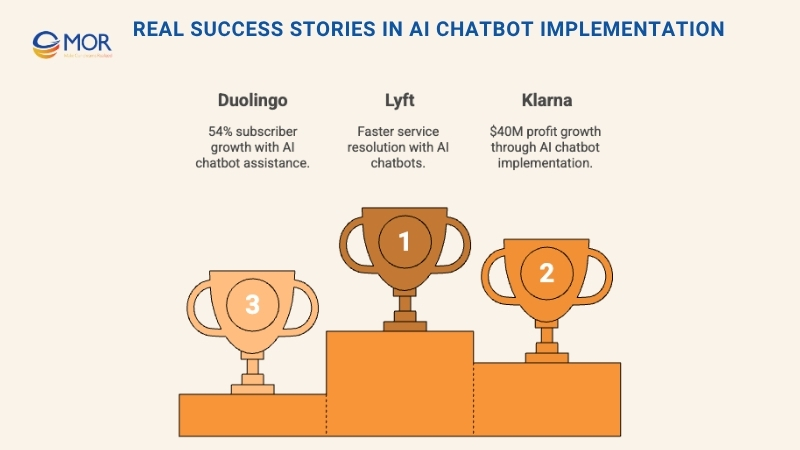
Lyft – Faster Service Resolution
Lyft, a major ride-hailing company, needed to scale its customer support quickly without losing quality. The team introduced an AI chatbot to manage frequent rider and driver questions. As a result, service resolution time became 87% faster.
This improvement helped human agents focus on complex issues, raising both productivity and customer satisfaction. Lyft’s story proves that using an enterprise-grade chatbot can speed up service while keeping support personal and efficient.
Klarna – $40M Profit Growth Through AI
Global payment leader Klarna used AI technology to reshape its customer service process. Its chatbot now manages about two-thirds of all customer conversations, powered by advanced conversational intelligence.
This move led to a $40 million yearly profit increase. The chatbot solved requests faster, cut the need for manual handling, and improved overall customer experience. Klarna’s success shows how smart planning in how to create AI chatbot systems can directly support growth and raise business performance.
Duolingo – 54% Growth In Paid Subscribers
Duolingo, the well-known language learning app, introduced AI chatbots to create a more personal and engaging learning experience. These smart “bot tutors” give instant feedback and adjust lessons to match each learner’s progress.
The result was a 54% rise in paid subscriptions. This case proves how how to create AI chatbot systems with adaptive learning features can increase user engagement, strengthen loyalty, and turn interactions into real business growth.
>>> Let's explore how AI consultancy and services empowers enterprises to transform operations and stay competitive in the digital era.
Common Challenges When Building An AI Chatbot
When businesses learn how to create AI chatbot systems, they often face several technical and practical challenges. Building a chatbot that truly meets user needs requires strong data protection, natural conversations, and seamless system connections.
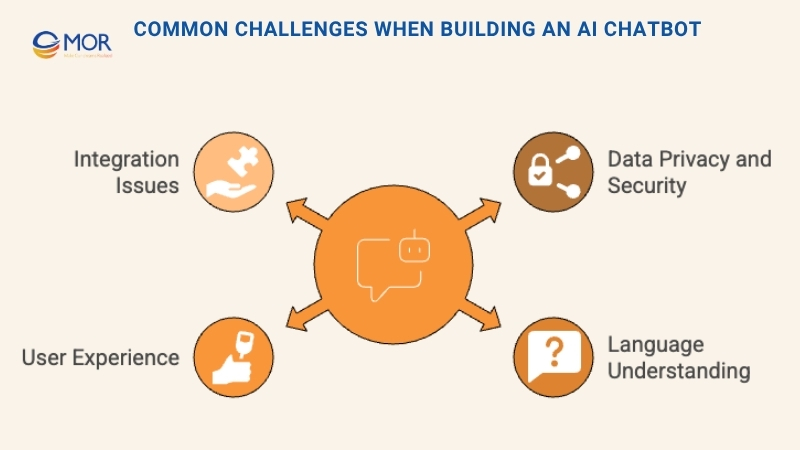
Data Privacy And Security
AI chatbots handle large volumes of user information, so protecting that data is critical. Following privacy laws and applying strong encryption methods help prevent leaks and build trust with users.
Language And Context Understanding
Human language is complex. Chatbots may struggle with slang, mixed expressions, or context changes. Improving intent recognition and maintaining smooth conversation flow is essential for accurate and satisfying replies.
User Experience
A chatbot must feel easy to use and pleasant to talk to. Poor design or unnatural answers can frustrate users and limit adoption. Focus on simple design, fast responses, and clear dialogue.
Integration Issues
Many companies find it difficult to link chatbots with CRMs, databases, or third-party systems. These integration challenges can slow deployment and reduce efficiency. Solving them ensures smooth performance and reliable automation.
The Future Of AI Chatbot Development
AI chatbot technology is advancing quickly, bringing smarter and more connected experiences to businesses and customers. As companies keep learning how to create AI chatbot systems for real-world use, new trends are shaping the next stage of conversational AI.
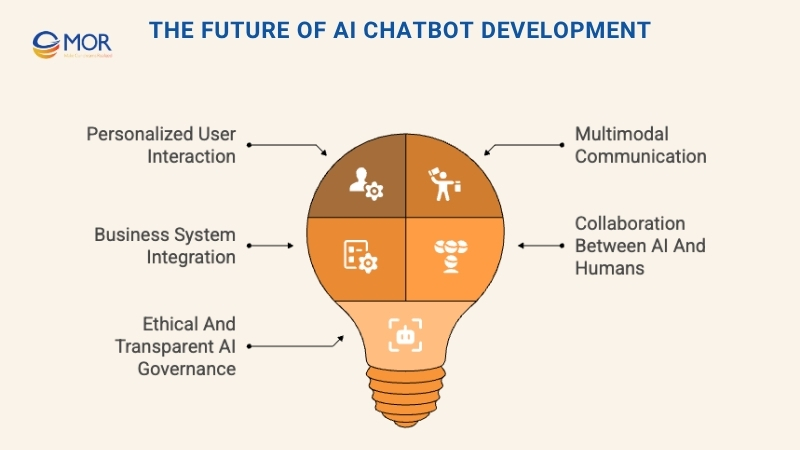
Personalized User Interaction
The next wave of chatbots will go beyond simple replies to deliver highly personal conversations. They will:
- Build Deep User Profiles: Use detailed data to understand each user’s habits, AI history timeline, and preferences.
- Offer Proactive Help: Predict what users need and respond before they even ask.
- Show Emotional Awareness: Recognize tone and emotion to make interactions more human and natural.
This level of personalization will help businesses create closer relationships and provide more meaningful user experiences.
Multimodal Communication
Future chatbots will no longer rely only on text. They will combine several ways of interaction to make communication richer and easier to use.
- Voice Integration: Users will speak naturally with chatbots and get instant spoken replies.
- Visual Support: Chats will include images, videos, or interactive tools for clearer understanding.
- Gesture Recognition: The system will read non-verbal cues like movements or expressions to respond more naturally.
These upgrades will make how to create AI chatbot systems more engaging, interactive, and closer to real human conversation.
Business System Integration
The coming generation of enterprise chatbots will connect even more deeply with core business systems and daily operations. They will:
- Automate Complex Tasks: Manage full processes across departments, like handling orders or guiding new employees through onboarding.
- Sync Data In Real Time: Keep all systems updated instantly for smooth coordination.
- Use Predictive Insights: Analyze chat data to spot patterns, predict trends, and support smarter business decisions.
This deeper integration will show how how to create AI chatbot solutions can move beyond support roles to become active parts of business growth and strategy.
Collaboration Between AI And Humans
Future chatbots will work alongside people instead of replacing them. They will function as smart assistants that enhance human performance and efficiency.
- Smart Routing: Send complex or sensitive cases to the right human agent with all the needed context.
- Agent Support: Give live suggestions, key details, and emotion analysis to help customer service teams respond faster.
- Ongoing Learning: Improve their knowledge by studying human interactions and updating responses over time.
This teamwork model shows that understanding how to create AI chatbot systems is not just about automation but about building smarter partnerships between technology and people.
Ethical And Transparent AI Governance
As chatbots become a core part of business operations, managing them responsibly will be essential. Companies will need to focus on fairness, openness, and control.
- Explainable AI: Help users understand how the chatbot makes its decisions or suggestions.
- Compliance Tools: Keep systems aligned with changing data protection and industry laws.
- Auditable Records: Store clear logs of all interactions to support tracking and accountability.
Strong governance ensures that businesses learning how to create AI chatbot systems can deploy them safely, earn user trust, and maintain long-term credibility.
How MOR Software Can Help Businesses Build An AI Chatbot
At MOR Software, we help businesses turn their chatbot ideas into powerful, AI automation tools. Our development teams combine expertise in software engineering, AI, and UX design to create chatbots that feel natural, reliable, and aligned with each company’s goals. Whether you need a customer service bot, an internal support assistant, or a sales automation tool, we build flexible systems that work smoothly across web, mobile, and enterprise platforms.
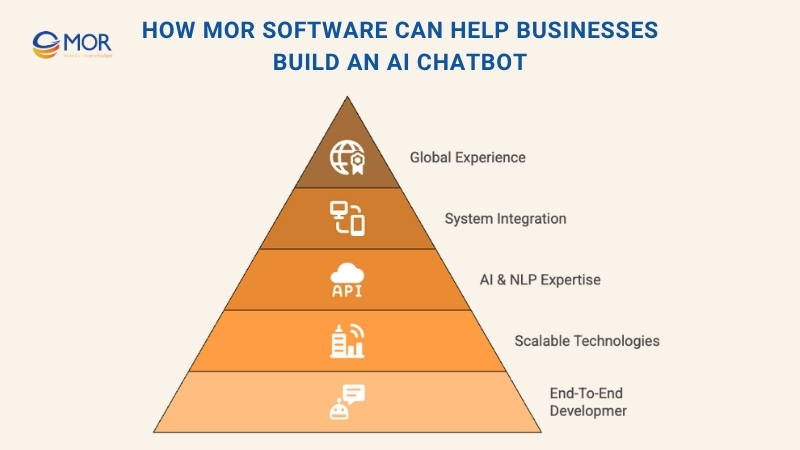
Our machine learning engineers use trusted technologies like Python, React Native, and .NET to develop scalable solutions that integrate easily with CRMs, ERPs, and cloud services. With deep experience in AI outsourcing, NLP, and machine learning, we design bots that understand context and deliver personalized, human-like responses. Every chatbot project includes thoughtful design and thorough testing to guarantee performance, security, and user satisfaction.
From planning and development to monitoring and updates, we provide full lifecycle support. Backed by more than 850 successful projects worldwide, MOR Software JSC is the trusted partner for companies ready to build intelligent, data-driven chatbots that improve customer engagement and streamline operations.
Contact us to bring your AI chatbot project to life.
Conclusion
Building an AI chatbot requires strategy, experience, and the right development partner. Knowing how to create AI chatbot solutions helps businesses connect faster, serve smarter, and grow stronger. With MOR Software’s proven expertise in AI, NLP, and automation, your chatbot can go beyond simple replies to deliver meaningful, human-like conversations. Ready to get started? Contact MOR Software today to build your intelligent chatbot solution.
MOR SOFTWARE
Frequently Asked Questions (FAQs)
Can I make my own AI chatbot?
Yes. Start by identifying your chatbot’s purpose and target users. Then choose where it will live, such as a website, app, or messaging platform. Select a suitable tech stack or builder tool, create a knowledge base, design conversational flows, integrate APIs, and test thoroughly before launching and monitoring your chatbot’s performance.
Can I create an AI chatbot for free?
It’s possible to build one for free using open-source tools or no-code platforms. Frameworks like Rasa, AutoGen, or tools such as Chatfuel and n8n let you connect free-tier AI APIs to create and deploy chatbots without upfront cost, though advanced features may require paid plans.
Is creating an AI chatbot difficult?
Not anymore. Modern platforms simplify the process with drag-and-drop interfaces and prebuilt AI components. While technical knowledge helps for advanced customization, most small or medium-sized projects can be built without coding experience.
How much does it cost to build an AI chatbot?
The cost varies widely. A simple chatbot might cost a few hundred dollars using DIY tools, while enterprise-grade chatbots with AI integration and multi-channel deployment can range from $40,000 to $150,000 depending on complexity and region.
How long does it take to build an AI chatbot?
A basic chatbot can be created in 2–4 weeks. More complex ones that involve natural language processing, custom integrations, and training may take 3–4 months or longer, depending on resources and project scope.
What programming language is best for chatbot development?
Python is the most common choice thanks to its large AI and NLP libraries, such as TensorFlow and spaCy. JavaScript, Java, and Node.js are also widely used for web-based chatbot development.
How can I train my own chatbot?
Training involves feeding your bot with phrases, questions, and sample conversations. Using NLP tools, you can map user intent and context so the chatbot learns how to respond accurately. The more data it’s exposed to, the smarter it becomes over time.
What tools are used to build AI chatbots?
Popular tools include Dialogflow, Microsoft Bot Framework, Rasa, and OpenAI API. No-code platforms like Tidio, Landbot, and Flow XO allow beginners to design bots quickly without writing code.
What industries benefit most from AI chatbots?
AI chatbots are widely used in customer service, healthcare, eCommerce, banking, education, and logistics. They help automate responses, streamline booking or purchasing, and provide 24/7 support.
Do I need coding skills to create an AI chatbot?
Not necessarily. Many no-code chatbot platforms allow users to design and deploy bots using templates and visual editors. However, coding knowledge helps customize advanced features like API integrations or unique conversational logic.
Is it legal to create a chatbot?
Yes, creating and using chatbots is legal when done responsibly. It becomes illegal only if the bot is used to perform fraudulent activities, spam, or violate platform terms of service.
How do AI chatbots understand human language?
They rely on natural language processing (NLP) and machine learning algorithms. These technologies analyze user input, identify intent, and generate contextually appropriate replies based on previous training data.
Can I integrate my chatbot with social media or websites?
Absolutely. Most chatbot platforms offer integration with popular channels like Facebook Messenger, WhatsApp, Telegram, Slack, or websites through widgets and APIs.
What makes a good AI chatbot?
A successful chatbot delivers clear, accurate, and natural responses. It understands user intent, maintains context, provides helpful information, and integrates seamlessly with business systems or databases.
How do I maintain and improve my AI chatbot after launch?
Monitor chatbot interactions regularly, analyze reports, and identify common user questions. Update the training data, refine dialogue flows, and test new scenarios to keep the chatbot accurate and relevant.
How is chatbot so smart?
A chatbot seems smart because it uses Artificial Intelligence (AI) and Natural Language Processing (NLP) to understand human language and respond naturally. It learns from large datasets, user interactions, and continuous updates to improve accuracy over time. This combination of data, algorithms, and training helps it recognize intent, context, and tone, making conversations feel human and intelligent.
Rate this article
0
over 5.0 based on 0 reviews
Your rating on this news:
Name
*Email
*Write your comment
*Send your comment
1